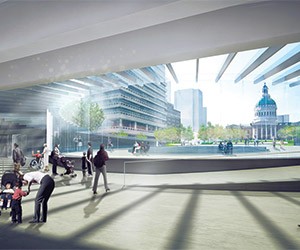It’s such an iconic element of the St. Louis skyline it seems like it was always there.
But while the success of the Jefferson National Expansion Memorial’s Gateway Arch in providing a lasting symbol of civic pride is undeniable, the monument commemorating the westward expansion of the U.S. that started in St. Louis was feeling its age after celebrating a golden anniversary last October.
After 50 years, maybe it was time for a makeover.
The $380 million CityArchRiver project aims to “connect, invigorate and expand the symbol of St. Louis and the nation through extensive improvements to the Arch grounds and its surroundings.” Begun in 2013 and targeting completion in fall 2018, the nonprofit CityArchRiver Foundation solicited some $250 million in fundraising for the project, which will also provide a host of benefits for meetings groups.
It turns out that many of the problems with the Arch grounds were baked in from the beginning. Due to a lack of funds to provide adequate pedestrian access to the monument, visitors had to cross a busy highway in order to visit—local wags describe it as playing Frogger, the early-1980s video game that featured frogs crushed by traffic. Not a good look.
“Since the day we opened the Arch we’ve been talking about how to get people over the freeway,” said Ryan McClure, communications director of the CityArchRiver Foundation, during a visit by Meetings Today. “This is meant to bring the entrance of the Arch into downtown St. Louis. The project was named CityArchRiver because that’s the three things that needed to be connected but weren’t.”
The access problem will be remedied by constructing a grand entrance via the “Park Over the Highway,” allowing visitors to stroll to the Arch grounds via the Old Courthouse via one continuous greenway—without a stair or a step—which in itself adds another scenic, even iconic, element to the monument.
Highlights of the project, which touch all 90 acres of the National Park Service-maintained Jefferson National Expansion Memorial, include the following:
- A massively revamped Gateway Arch Museum and Visitor Center that will feature an additional 46,000 square feet of space for private events, for a total of 150,000 square feet.
- Classroom and mezzanine space in the Visitor Center that can seat 150 for a dinner event.
- Complete renovation of all of the exhibits under the Arch.
- The addition of 1,600 trees, to bring the national park’s total to 4,000.
- An events lawn with a capacity to hold 2,000 people.
- A 7.5-acre greenspace at the North Gateway to replace a parking garage.
The project also includes the raising of the Mississippi riverfront by two feet over a mile and a half for flood control and providing walking and biking trails, which signifies a giant shift in civic priorities.
“You really had a city that turned its back on the river,” Ryan said of the history of St. Louis’ long neglect of what could’ve been a natural visitor asset in the Mississippi River.
For groups that want to meet at the monument, National Park Service (NPS) rules stipulate that the gathering must have a purpose that fits its historic mission when not held after park hours. There’s a possibility that could change, according to Ryan, following dialogue with the NPS.
With 50 years of potential soon to be fully realized, St. Louis will now boast a symbol it can share even further with the world.
“It’s one of the few urban national parks in America.” Ryan said. “It’s been an important civic gathering place but never been used to its full potential.”
More information:
www.cityarchriver.org




